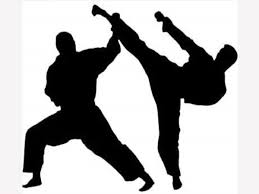SLAVIC-GORITSKAYA FIGHT (part5)
 Blade fight. It starts from the position of the connected knives in the arms of the rivals stretched forward by the command of the field judge: “Kon!” The judge must evaluate each qualified action of the opponents, while stopping the battle with the Wonmi! Team.
Blade fight. It starts from the position of the connected knives in the arms of the rivals stretched forward by the command of the field judge: “Kon!” The judge must evaluate each qualified action of the opponents, while stopping the battle with the Wonmi! Team.
Blade combat distinguishes between certain types of strikes and the area of destruction (with the symbols “A”, “B” and “C”). A strong and technically correctly delivered blow (not taken away and not extinguished by the opponent), executed in area “A” or “B”, is recognized as stabbing. A strong cutting blow (that is, capable of cutting in a real battle) to area “B” is recognized as undercutting. Depending on the nature and location of the strike, the participant receives a certain number of points, which are then added up. So, for example, a victory can be counted for: one prick to region “A” + one prick to region “B” + two clippings to region “B”, which gives a total of 5 points.
For strikes made by opponents at the same time, both strokes are evaluated. For strikes performed by them sequentially, only the first strike is evaluated. With the successive execution by one fighter of several productive strikes, only the very first of them is evaluated.
FIRE FIGHT.
They are carried out in two versions: a single shot and a triple shot.
After the command of the field judge “Kon!”, The opponents must enter the area and hit the enemy from any distance (but not beyond its limits) using the appropriate number of shots. During the fight, any means of moving around the site (including step, running, jumping, somersaults, rumbles and acrobatic stunts), protection by the Svili technique and fire suppression of enemy actions are allowed.
In Firefight, the following rating system is adopted:
– incoming hit in any part of the head, in the throat or in the neck, in the middle or left side of the chest (back), in the right side of the abdomen or lower back – the highest score;
– incoming hit in the stomach, right side of the chest or back, in the collarbone, in the shoulder, in the thigh, in the knee – the average score;
– incoming hit in the lower leg or forearm, or a sliding hit on the leg (on the arm, on the head, on the body) – the lowest score.
The results of the shots are summed up, and on their basis the winner is determined – the shooter, the first to score the required number of points.
A net victory (an early stop of the battle) is counted upon receiving the highest score. Victory with a clear advantage (early stop of the battle) is recognized as receiving 2 average points. A technical victory is the receipt of 1 average point or 3 lowest points. If the highest or average scores are equal, mutual defeat of opponents is recognized. A mutual mistake of opponents or the presence of 1-2 lower scores is recognized as a draw.




